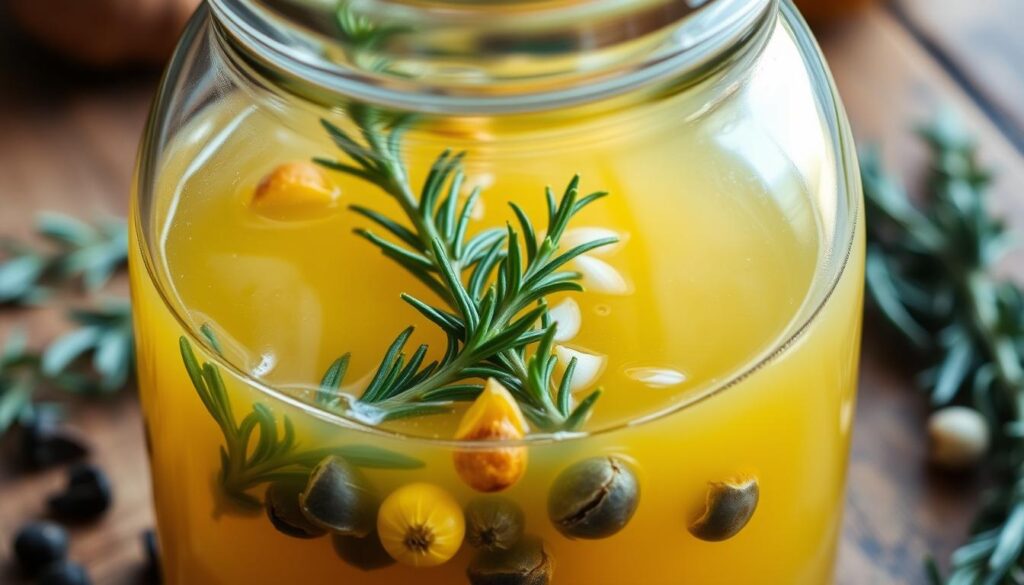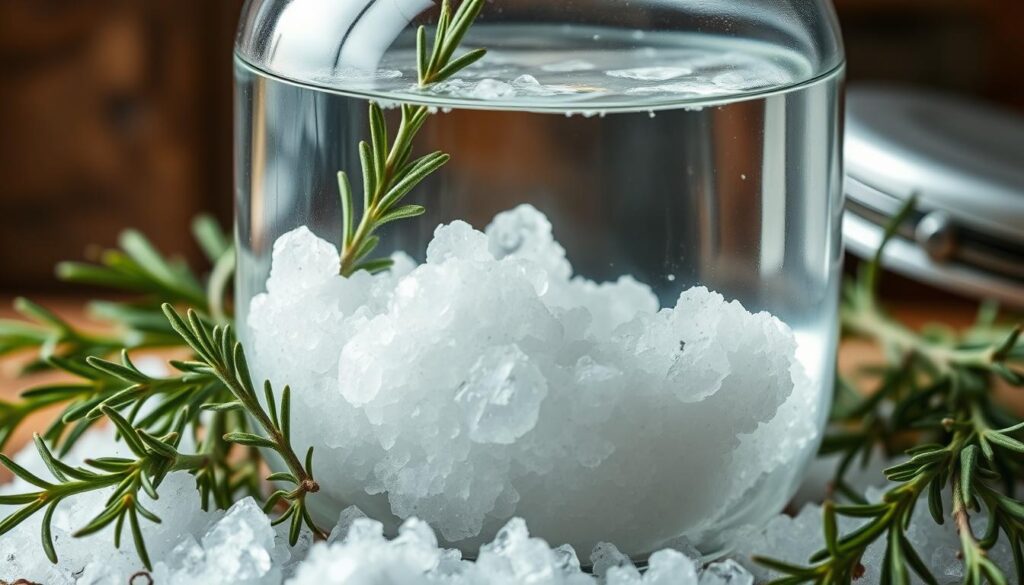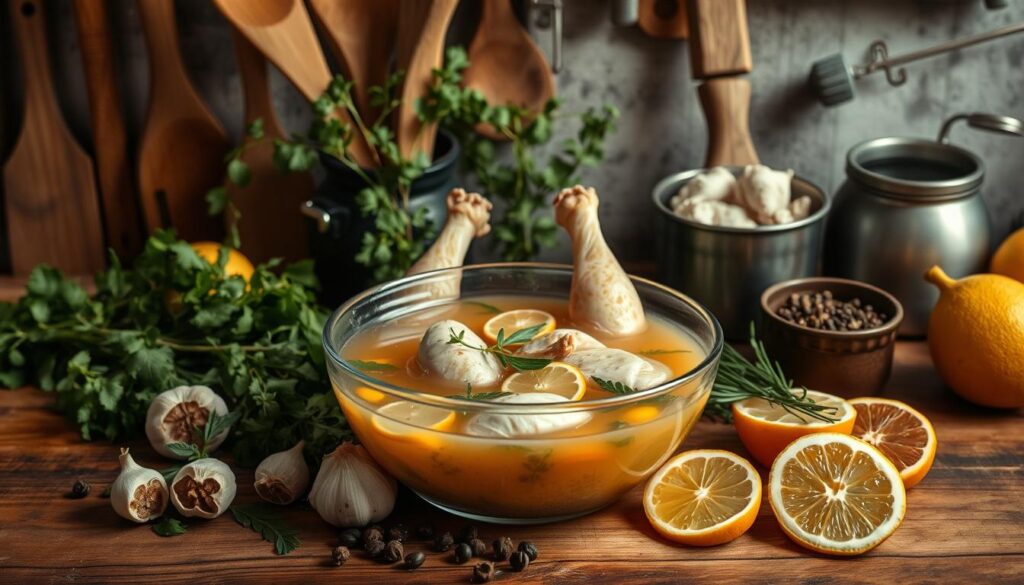Ever had chicken so tender and juicy it melts in your mouth? The secret is brining. By soaking your chicken in a salt solution, you unlock amazing flavors and textures. Your family and friends will love it.
Table of Contents
We’ll explore the science of brining and share a simple recipe. This will make your chicken dishes incredibly delicious. Whether you’re new to cooking or experienced, this guide will help you make tender, juicy chicken. Everyone will want more.
Ready to make your chicken dishes amazing? This simple brining method will impress your loved ones. Let’s discover how to make your poultry tender and juicy.
Understanding the Science Behind Chicken Brining
Brining chicken is a simple yet effective technique that transforms ordinary poultry into a succulent, flavorful delight. But have you ever wondered what’s happening behind the scenes? Let’s dive into the science that makes chicken brining so powerful.
How Salt Penetrates Meat Fibers
The key to brining’s success lies in the behavior of salt. When you submerge chicken in a salt-water solution, the salt molecules begin to penetrate the meat fibers. This process is driven by a phenomenon known as osmosis, where water and dissolved substances move across a semi-permeable membrane (in this case, the chicken’s cell walls) to reach equilibrium.
The Role of Osmosis in Brining
As the salt enters the meat, it alters the natural balance of the chicken’s cells. The cells then draw in water from the surrounding brine, plumping up the muscle fibers and locking in moisture. This is the essence of brining – using the principles of osmosis to hydrate the chicken and prevent it from drying out during cooking.
Why Brined Chicken Stays Juicier
The water that the chicken absorbs during brining acts as an internal “reserve,” keeping the meat moist and tender even when subjected to the high heat of cooking. This is why brined chicken marinade and wet brine recipe techniques are so effective – the salt and water brine helps the chicken retain its natural juices, resulting in a succulent, flavorful final dish.
By understanding the science behind chicken brining, you can unlock the secret to consistently juicy, tender poultry every time. Get ready to impress your family and friends with your newfound brining expertise!

Essential Ingredients for a Simple Chicken Brine
To make a tasty and moist chicken brine, you need just a few things. At the core are salt and water. These are the base for the brine, adding moisture and flavor to the chickenhttps://alphacomworkforce.com/chicken/. You can also try flavored brines with extra ingredients for more taste.
Here are the main ingredients for a simple chicken brine:
- Salt – Salt is key in brining. It breaks down the chicken’s fibers, making it more moist and flavorful. Use kosher or sea salt for the best taste.
- Water – This is the liquid that dissolves the salt, making the brine solution for the chicken.
- Flavor Enhancers (Optional) – For even more flavor, add herbs, spices, citrus, or other aromatics. Garlic, peppercorns, bay leaves, thyme, rosemary, or lemon and orange peels are great choices.
Knowing the role of these ingredients helps you make a brine that makes chicken juicy and full of flavor.
| Ingredient | Purpose |
|---|---|
| Salt (Kosher or Sea) | Helps break down muscle fibers and enhances moisture absorption |
| Water | Dissolves the salt to create the brine solution |
| Herbs, Spices, Citrus (Optional) | Adds additional flavors and aromatics to the brine |
Basic Salt-to-Water Ratio for Perfect Brining
Getting the perfect chicken brine is all about the right salt-to-water ratio. Whether you’re making a wet brine or a simple brine, knowing the best proportions is crucial. It makes your poultry juicy and flavorful.
Measuring Salt Types Correctly
The type of salt you use in brining matters. Kosher salt, sea salt, and table salt have different densities. So, you need to measure them differently.
Use 1/2 cup of kosher salt or 1/4 cup of table salt for every 1 gallon of water. If you’re using a different salt, adjust the measurements accordingly.
Water Temperature Guidelines
- For the best salt dissolution, use warm or hot water (around 120°F) when making your brine.
- After the salt is dissolved, cool the brine to room temperature or below. Then, add your chicken.
Adjusting Ratios for Different Chicken Cuts
The standard 1/2 cup of kosher salt per 1 gallon of water is a good starting point. But, you might need to adjust the ratio for different chicken cuts. Thinner pieces like breasts or tenders might need less salt. Heavier cuts like drumsticks or thighs can handle more.
| Chicken Cut | Salt-to-Water Ratio |
|---|---|
| Whole Chicken | 1/2 cup kosher salt per 1 gallon water |
| Chicken Breasts | 1/3 cup kosher salt per 1 gallon water |
| Chicken Thighs | 3/4 cup kosher salt per 1 gallon water |
Remember, the key is to experiment and find the perfect balance of salt and water. This balance should suit your specific chicken cuts and taste preferences.

Step-by-Step Simple Chicken Brine Process
Brining your chicken makes it juicy and tender every time. Here’s how to do it easily:
- In a big container, mix the salt with warm water. Use 1/4 cup of kosher salt for every quart of water.
- Let the brine cool down to room temperature or chill it in the fridge.
- Put the chicken in the brine, making sure it’s fully covered. Then, refrigerate it for 30 minutes to 12 hours, depending on the cut.
- After brining, take the chicken out and dry it with paper towels. Now, it’s ready for cooking.
The secret to a great simple chicken brine is finding the right balance. Adjust the salt, water, and brining time to fit your needs.
| Chicken Cut | Brining Time |
|---|---|
| Whole Chicken | 8-12 hours |
| Bone-in Chicken Breasts | 2-4 hours |
| Boneless, Skinless Chicken Breasts | 30 minutes to 2 hours |
| Chicken Thighs | 2-4 hours |
| Chicken Drumsticks | 2-4 hours |

By following these steps, you’ll get juicy, flavorful chicken every time. Try different pre-cooking chicken brine ingredients and methods to find your favorite easy chicken preparation.
Flavor Enhancers and Optional Aromatics
Adding a few aromatic ingredients can make your chicken brine taste amazing. Try using fresh herbs, spices, citrus, and sweet or savory items. This way, you can make a marinade that makes your chicken juicy and full of flavor.
Fresh Herbs and Spices Options
Herbs like rosemary, thyme, sage, and oregano can add earthy, savory flavors to your flavored brine. Whole peppercorns, crushed garlic, and minced ginger also bring depth and complexity to your chicken marinade. Mix different herbs and spices to find the perfect flavor for your dish.
Citrus and Aromatics Combinations
Adding a bit of citrus, like lemon, lime, or orange, can brighten your juicy chicken brine. It adds a refreshing contrast. Mix citrus zest and juice with bay leaves, fennel seeds, or star anise for a unique and flavorful marinade.
Sweet and Savory Additions
Try adding a bit of sweetness with honey, brown sugar, or maple syrup. This subtle sweetness can balance the brine’s saltiness. Savory elements like soy sauce, Worcestershire sauce, or Dijon mustard also add complexity to your flavored brine.
Play with different herbs, spices, citrus, and sweet or savory items. Find the perfect chicken marinade that matches your taste and cooking style.

Optimal Brining Times for Different Chicken Cuts
Brining chicken makes it juicy and tender. But, the right brining time varies by chicken cut. We’ll look at the best brining times for different chicken pieces to enhance your poultry brining skills.
Whole Chickens
For a whole chicken, brine for 12 to 24 hours. This long soak lets the meat absorb salt and flavors, making it moist and flavorful.
Chicken Breasts
Boneless, skinless chicken breasts need only 2 to 6 hours of brining. This short time avoids over-salting and keeps the meat tender.
Chicken Thighs and Legs
Thighs and legs can brine for 4 to 8 hours. Their meat becomes juicier and more flavorful with this extra time.
Chicken Wings
Brine chicken wings for 2 to 4 hours. This balances flavor infusion without over-salting, ensuring delicious easy chicken preparation.
These times are just a guide. Adjust based on chicken thickness, taste, and recipe. Taste as you go to find the best brining time for your pre-cooking chicken brine.
| Chicken Cut | Optimal Brining Time |
|---|---|
| Whole Chicken | 12 to 24 hours |
| Chicken Breasts | 2 to 6 hours |
| Chicken Thighs and Legs | 4 to 8 hours |
| Chicken Wings | 2 to 4 hours |
Follow these guidelines for the best poultry brining results. Happy brining!

Common Brining Mistakes to Avoid
Brining your chicken can make it incredibly juicy and tender. But, there are common mistakes to watch out for. These include over-brining and temperature control issues. Let’s look at how to avoid these mistakes.
Over-Brining Problems
Brining your chicken right can make a big difference. But, brining it for too long can make it too salty and soggy. Stick to the recommended brining times for your chicken cut. And, take the chicken out of the wet brine recipe when it’s just right.
Temperature Safety Issues
Keeping the right temperature during brining is key for safety. Make sure your juicy chicken brine stays cool, between 35°F and 40°F. Warm temperatures can lead to harmful bacteria, ruining your chicken’s safety and taste.
Container Selection Tips
- Choose a non-reactive container like plastic, glass, or stainless steel to avoid chemical reactions.
- Make sure the container is big enough to cover the chicken completely.
- Cover the container to keep the temperature right and prevent contamination.
By avoiding these common mistakes, you’ll get perfectly juicy, tender chicken every time.
Post-Brining Preparation Techniques
After brining, it’s key to handle your chicken right for the best results. First, rinse the chicken under cool water to get rid of extra brine. This stops the meat from getting too salty. Then, dry the chicken with paper towels to soak up any moisture.
Now that your chicken is ready, you can cook it. You might roast, grill, or sauté it. The steps before cooking are vital to keep the chicken moist and tender. Remember, the pre-cooking chicken brine makes sure your chicken stays juicy.
Use these easy chicken preparation tips to make perfectly brined and cooked chicken every time. A good brine and proper handling before cooking make your chicken the highlight of the meal. Your family and guests will be impressed.
FAQ
What is the purpose of brining chicken?
Brining chicken makes the meat moist, tender, and full of flavor. The salt in the brine gets into the chicken’s muscle fibers. This helps the meat keep more moisture and taste better.
What are the essential ingredients in a simple chicken brine?
For a basic chicken brine, you need salt, water, and extra flavors like herbs, spices, or citrus.
What is the ideal salt-to-water ratio for brining chicken?
Use 1/4 cup of salt for every 1 quart (4 cups) of water. You can adjust this ratio based on the salt type and chicken size.
How long should I brine chicken?
Brining time varies by chicken cut. Brine whole chickens for 4-6 hours, breasts for 2-4 hours, and thighs or drumsticks for 1-2 hours.
Can I add any extra flavors to the brine?
Yes! You can add fresh herbs, spices, citrus, or sweet and savory ingredients. This lets you customize the chicken’s flavor.
What are some common mistakes to avoid when brining chicken?
Avoid over-brining, not controlling brine temperature, and using the wrong container. Stick to recommended times and use a non-reactive container for the best results.
How should I prepare the chicken after brining?
After brining, rinse the chicken and dry it well. This helps it brown and crisp up when cooked.

